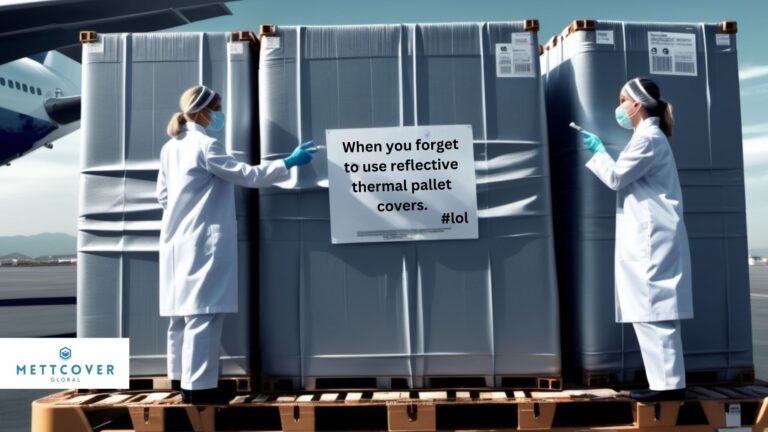Thermal Pallet Covers for Tarmac? Make sure your covers reload.
- Mettcover Global

When you entrust your temperature-sensitive cargo, like pharmaceuticals, on a journey through air freight, the surprises awaiting your goods in terms of external temperatures can be startling. Imagine sending a package from Singapore to Sweden, the external temperatures at different airports can be vastly different during transport and storage. The open air, with temperatures soaring to +50°C in warm countries or plunging to -30°C in cold countries, creates a critical “Hazardous Critical Control Point” (HCCP) in the cold chain.
Let’s imagine this together: A package full of medicines standing on the airport tarmac. It might seem like a routine wait, but here’s the twist – this moment on the tarmac is more than just a point in transit. During tarmac delays, when your pharmaceutical cargo is left waiting on the airport tarmac, the temperatures can skyrocket to levels 50°F higher than the ambient levels. Surprisingly, the seemingly secure choice for shipping valuable therapies – air transport, turns out to be the riskiest, contributing to a whopping 80% of all reported temperature excursions.
International shipments, in particular, add another layer of risk. The product is out of the manufacturer’s control, relying on various partners, including third-party logistics. The complexity is evident in the delays and bureaucratic hurdles faced, such as the 10 to 20 days it can take in some EU regions just to get the permits required to move the product from the airport to ground transportation.
Pharmaceuticals and Healthcare in Airfreight:
When transporting time-temperature sensitive pharmaceuticals or healthcare products by air freight, ranging from chilled (+2°C to +8°C) to ambient (+15°C to +25°C), the decision between active cooling (cooler engines), passive cooling (insulated packaging), or a combination depends on temperature requirements and available equipment in the cold chain. Actors in the temperature-controlled supply chain, such as freight forwarders, warehouses, and air freighters, influence this choice. If they offer temperature-controlled storage or transport covering HCCPs during overload procedures, active cooling might be suitable; otherwise, adding or singularly using a passive cooling system is advisable. Although the modality of the solution will widely vary as per the shipping label temperature.
Single Temperature Excursion & Thermal pallet Covers
Thermal Pallet Covers address HCCPs in the cold chain by providing temperature protection during critical control points where external temperatures deviate from the product’s temperature barriers. The infamous Tarmac Time on airfields, where goods stand unprotected in varying temperatures for several hours during loading, is a glaring example. This prolonged exposure directly impacts the temperature-sensitive pharmaceuticals. In such a scenario, Reflective Thermal Covers offer protection for single peak or temperature excursions, primarily because depending on their build, thermal pallet covers boast up to 90% reflectivity, thereby minimizing temperature shocks owing to the impact of direct sunlight.
Thermal “Re-Loads” and Thermal Pallet Covers
Using thermal blankets or covers for transporting pharmaceuticals requires understanding that only the thermal energy of the products is utilized and protected. No additional thermal energy sources, like gel packs or ice packs, are employed, especially when the shipments are protected within the 15°C – 25°C. It is noted that some industry players are complementing the insulation properties of thermal covers with PCMs and delivering good results, mostly in cases of maintaining cargo in the 2°C – 8°C range. However we are still collecting valid scientific data on this use case and therefore will abstain from recommending or discouraging the practice.
The insulation quality of the passive cooling system must suffice for temperature protection. Such packaging allows for “thermal reloads” which are specific locations in the cold chain where lost thermal energy can be restored. These reloads are crucial for ensuring optimal temperature protection and payload efficiency for subsequent excursions.
Thermal “Reloads” for Ambient Pharmaceuticals:
In the case of ambient pharmaceuticals (+15°C to +25°C), the “thermal reloads” scenario is advantageous. The working stations at various cold chain actors, operating at an average temperature of (+18°C), serve as ideal thermal reload situations. This favorable condition within the pharmaceutical product’s temperature barriers explains the growing implementation of thermal blankets and covers. These solutions not only provide optimal temperature protection but also contribute to an efficient payload ratio which is a critical factor in determining transport costs for airfreight of pharmaceuticals.
CEIV’s Response: Thermal Blankets as a Shield
Recognizing the urgency of addressing temperature excursions during air transport, the International Air Transport Association (IATA) established the Center of Excellence for Independent Validators (CEIV) Pharma Logistics program in 2014. This initiative aimed to set global air transportation standards for pharmaceuticals, certify stakeholders using best practices, and foster collaboration.
CEIV’s efforts have shown progress. As of the latest update, 221 organizations are CEIV-certified, and over 75 more are in the certification process. The program has introduced a bulletin board to help pharmaceutical and biopharmaceutical companies connect with certified partners, facilitating collaboration.
A critical recommendation from CEIV has been the use of thermal pallet blankets, equipped with advanced insulating materials and aimed at keeping pharmaceuticals at stable temperatures during the critical tarmac time.
The Dynamics of Tarmac Time: Why It Matters
The tarmac introduces a set of challenges that standard regulations may not fully capture. When your cargo is on the tarmac, it faces the roulette of temperature fluctuations. The reported ambient temperature might seem manageable, but additional factors come into play. Under clear skies, cargo surfaces can absorb the sun’s rays, leading to temperatures exceeding 60°C or even 70°C. This dynamic demands a nuanced approach to temperature control during the critical transition phases.
Reflectivity plays a big role against temperature excursions. While many thermal packaging systems boast high reflectivity values, real-world measurements reveal variations. Some aluminized materials, for instance, absorb about 20% of the sun’s energy, potentially heating up the cargo. This underscores the importance of understanding the true reflectivity of materials, as opposed to relying solely on stated values.
The choice of thermal protection systems is crucial for shielding pharmaceuticals from temperature excursions. These systems range from insulated boxes to thermal blankets and passive thermal shipping containers. However, a significant challenge lies in the disparity between thermal chamber testing and real-world conditions. Manufacturers often specify systems based on data obtained in thermal chambers, which may not fully replicate the conditions on the tarmac.
Decoding Labels: PIL vs. PER in Pharma Logistics
The choice of labels – PIL (Pharmaceuticals) versus PER (Perishables) is not a mere semantic decision but a strategic move with sizable ramifications. Labeling pharmaceutical shipments as perishables might seem a cost-cutting tactic, but the repercussions include negative impact on service and quality issues. Choosing the PIL label, specifically designed for pharmaceuticals, is a valid investment in ensuring proper handling and maintaining the integrity of the cargo. While opting for the PER label might seem an avenue for reducing costs, the resultant service and quality problems can quickly outweigh the perceived savings. The pharmaceutical industry operates on a delicate balance of precision and reliability, where compromised quality can lead to substantial financial losses and reputational damage.
Looking Ahead: Future-Proofing Pharma Logistics
The fight against temperature excursions isn’t an individual skirmish; it’s a collaboration where airlines, airports, logistics providers, and pharmaceutical manufacturers converge. As pharmaceutical logistics evolve, the role of thermal blankets becomes increasingly vital. It’s not just a shield; it’s a proactive approach to tackle challenges in temperature controlled air transport. Thermal blankets stand as steadfast companions in the journey of ensuring the safe and potent delivery of pharmaceutical lifelines.




